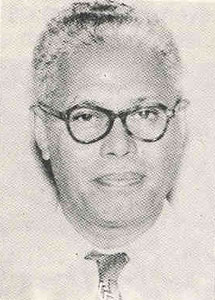Martinus Putuhena
Martinus Putuhena | |
|---|---|
 | |
| 2nd Minister of Public Works | |
| In office 14 November 1945 – 26 October 1947 | |
| Prime Minister | Sutan Sjahrir |
| Preceded by | Abikusno Tjokrosujoso |
| Succeeded by | Mohammad Enoch |
| 5th Prime Minister of East Indonesia | |
| In office 10 May 1950 – 16 August 1950 | |
| Preceded by | D. P. Diapari |
| Succeeded by | Office abolished |
| Personal details | |
| Born | 27 May 1901 Saparua, Dutch East Indies |
| Died | 20 September 1982 (aged 81) Jakarta, Indonesia |
| Political party | Indonesian Christian Party |
Martinus Putuhena (27 May 1901 – 20 September 1982) was an Indonesian engineer and politician. He was the Minister of Public Works under Sutan Sjahrir during the Indonesian National Revolution, and briefly served as the Prime Minister for the State of East Indonesia prior to its dissolution.
Originating from Saparua, Putuhena was educated at the Technische Hoge School in Bandung before working as an engineer for the colonial government. After his governmental career as public works minister during the Indonesian National Revolution, Putuhena was appointed to the State of East Indonesia initially as a compromise candidate for a security takeover, before the political situation resulted in a complete takeover which he supervised. He continued to work under the government until 1958, before entering the private sector as a consultant.
Early life and education
Putuhena was born on 27 May 1901 in the village of Ihamahu, on the island of
After AMS, Putuhena decided to continue to the Technische Hoge School (THS) in Bandung, instead of the medical school STOVIA. He had initially wanted to continue his studies at the Netherlands, but the Ambonsch Studiefonds, his sponsor organization that also funded the studies of other future Ambonese leaders, lacked needed funds. At THS, he studied "wet" civil engineering. During this period, Putuhena became friends with Sukarno who was one year his senior at THS, and he joined Sukarno's Algemeene Studieclub. He graduated as an engineer in 1927.[3][4]
Career
After graduating, Putuhena began to work at the Public Works Department of the colonial government, supervising the construction of the Bandung Post Office as his first assignment. He was reassigned several times - to
After the
By late 1949, with the revolution coming to a close, a question arose regarding security forces in the
Following his return, he was appointed as Secretary-General of the ministry of public works, a position in which he remained until 1956. In this capacity, Putuhena established an academy of public works and arranged for Indonesian engineers to be trained abroad.[19] After his retirement, he rejected an offer to be Ambassador to Burma and was placed in the board of Billiton Indonesia, negotiating the company's takeover by the Indonesian government to form PT Timah.[20]
Later life

After his retirement from Billiton, Putuhena began working in the private sector, starting a consulting firm to advise on the construction of an
Putuhena died on 20 September 1982, at the
References
- ^ Leirissa 1985, pp. 1–9.
- ^ Leirissa 1985, pp. 19–27.
- ^ Leirissa 1985, pp. 28–32.
- ^ Chauvel 2008, p. 74.
- ^ Leirissa 1985, pp. 34–36.
- ^ Sejarah Kebangkitan Nasional Daerah Nusa Tenggara Barat (in Indonesian). Direktorat Jenderal Kebudayaan. 1991. p. 141.
- ^ Leirissa 1985, pp. 41–45.
- ^ Leirissa 1985, pp. 47–48.
- ^ Leirissa 1985, p. 54.
- ^ Chauvel 2008, p. 203.
- ^ Leirissa 1985, pp. 55–56.
- ^ Leirissa 1985, pp. 64–68.
- ^ Chauvel 2008, pp. 321–322.
- ^ Agung 1996, pp. 713–714.
- ^ Agung 1996, pp. 741–772.
- ^ Agung 1996, p. 773.
- ^ Leirissa 1985, p. 77.
- ^ Chauvel 2008, p. 381.
- ^ Leirissa 1985, pp. 79–84.
- ^ Leirissa 1985, pp. 96–97.
- ^ Leirissa 1985, pp. 98–100.
- ^ Leirissa 1985, pp. 101–102.
- ^ Leirissa 1985, p. 107.
- ^ Tri Hanggoro, Hendaru (19 May 2019). "Ketika Rumah Menteri Pekerjaan Umum Kena Gusur". Historia (in Indonesian). Retrieved 9 January 2022.
- ^ "Ir Putuhena Meninggal". Kompas (in Indonesian). 21 September 1982. Retrieved 31 December 2021.
- ^ a b Leirissa 1985, p. 108.
- ^ 45 tahun Departemen Pekerjaan Umum (in Indonesian). Departemen Pekerjaan Umum. 1990. p. 30.
Bibliography
- Agung, Ide Anak Agung Gde (1996). From the Formation of the State of East Indonesia Towards the Establishment of the United States of Indonesia. Yayasan Obor Indonesia. ISBN 978-979-461-216-3.
- Chauvel, Richard (2008). Nationalists, Soldiers and Separatists: The Ambonese Islands from Colonialism to Revolt, 1880-1950. BRILL. ISBN 978-90-04-25395-7.
- Leirissa, R. Z. (1985). Ir. Martinus Putuhena: karya dan pengabdiannya (in Indonesian). Departemen Pendidikan dan Kebudayaan, Direktorat Sejarah dan Nilai Tradisional, Proyek Inventarisasi dan Dokumentasi Sejarah Nasional.
